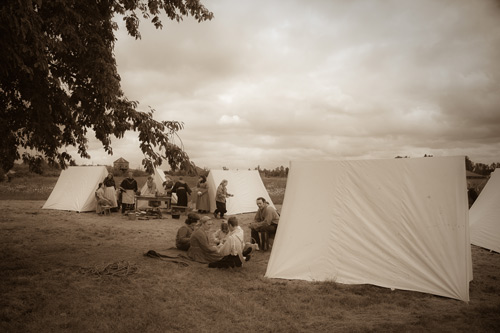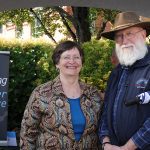Exodus for Jobs and Opportunity Builds Multi-cultural Vancouver

Clark College celebrates 80 years in a region rich with historical diversity. Pictured here is a re-enactment of living conditions at Fort Vancouver.
Photo by Robert Holcomb
by Van Forsyth
Captains Lewis and Clark led a multi-national, multi-racial group across the continental divide and back.
Outside Fort Vancouver was a cottage industry—people from Scotland, French Canada, Ireland, England, Hawaii and more than 30 different regional Native American tribes.
It was World War II that formally brought this region into the modern, industrial era and further diversified its population.
It could have occurred this way: Concomly, a Chinook chief and father, is teaching his son fishing skills on the banks of the Columbia River, not far from what is Vancouver, Wash., today. As the two turn their gaze down river, they see a long boat and its crew struggling to make headway against the mighty current of North America’s fourth largest river.
Lt. William Broughton and his British crew would be the first Europeans to navigate the Columbia River, view the volcanic peaks of Mount St. Helens and Mount Hood and meet some of the thousands of natives who inhabited the diversely populated Northwest. If Concomly was to stand on the banks of the Columbia and witness the change over the next 200 years, he would see the arrival of immigrants, commercial organizations, military fortifications and educational institutions like Clark College.
The physical, demographic and commercial landscape of Southwest Washington has undergone huge changes since the days of Concomly—as has Clark College over the last eight decades. If the Chinook chief was an historian today, where would he place Clark College in the continuum that is the history of this region?
Multi-racial exploration
Early European exploration of the Pacific coast of North America began with the Spanish in the 16th century. Though their examination of our region was rudimentary and produced limited information, contact was made with the coastal Indians. But it was not until the 18th and early 19th centuries that European and American exploration proved fruitful in understanding the geography and people of the Pacific Northwest.
Early immigrants of the Northwest saw the diversity of people who inhabited the region. No one understood this more than the members of the Corps of Discovery. For two years, the men and women of the Lewis and Clark expedition peacefully interacted with the native population, firing their weapons in defense only once at Blackfoot Indians.
The early settlers had plans to establish a comprehensive peace plan among the Indians, but what the dominant Blackfoot saw was a balance of power about to change. Several Blackfoot tried to steal weapons from the Corps and in the ensuing firefight two Blackfoot Indians were killed. This was the only hostile encounter the Corps experienced with the natives during the entire expedition.
Perhaps what helped the expedition understand and relate to the different tribes on their trek was the diversity of the Corps itself. Captains Lewis and Clark led a multi-national, multi-racial group across the continental divide and back with the significant assistance of a Shoshone woman named Sacagawea. Chief Concomly met the Corps and was introduced to a quintessential moment in the region’s history—a time when the Pacific Northwest was about to experience monumental changes.
Migration enhanced the region’s culture
Concomly lived long enough to see one of the first permanent European commercial enterprises along the banks of the Columbia River—an outpost for the Hudson’s Bay Company (HBC). As Fort Vancouver grew via this British fur-trading company, so did the neighboring population.
While John McLoughlin, chief factor at Fort Vancouver, managed the operation from inside the fort, outside a village of cottage industry workers also evolved. This village—on the west side of the palisade—included people from two continents and dozens of regional Native American tribes. All lived and worked collaboratively creating a uniquely mixed culture.

Portrait of Chief Concomly. Duncan McDougall, Astoria Journal. Astoria, Ore.,1811-1813. The Rosenbach Museum & Library, Philadelphia. AMs 1293/11
Concomly died in 1830 and did not witness the significant migration of Americans arriving in the Northwest via the Oregon Trail. For many, the first stop before heading to the fertile Willamette Valley was Fort Vancouver. Hoping to restock their supplies after six months and 2,000 miles on the trail, they found a generous John McLoughlin who obliged, even providing a line of credit for some.
The second half of the 19th century resulted in the establishment of the permanent political boundaries of the Northwest, much of this at the expense of Concomly’s people and other Native American tribes’ land claims.
Statehood for Oregon in 1859, Washington in 1889 and Idaho in 1890, ended the territorial status for Northwest inhabitants. The HBC left Fort Vancouver about the time the United States Army established the Columbia Barracks (later renamed the Vancouver Barracks). Notable military residents at the barracks included Ulysses Grant, Philip Sheridan, George C. Marshall and Clark College’s current president, Robert K. Knight, who was the last official to hold the command post.
Modern era
The Northwest in the early 20th century was still sparsely populated and relied on an extractive economy, primarily timber. Though the railroads helped connect the region to the industrial matrix of the nation, it took the Great Depression to propel the Northwest from meager frontier living to the boom of the modern economic era.
In the same year that Franklin D. Roosevelt was inaugurated for his first term as president (1933), Vancouver Junior College was established as a private two-year institution. FDR’s New Deal began to pump millions of dollars into the building of the Bonneville and Grand Coulee dams. With unemployment at more than 35 percent, the dire need for jobs attracted Americans from across the country, and the college was accessible for the necessary education.
But it was World War II that formally brought this region into the modern, industrial era and further diversified its population. The Kaiser Shipyards in Vancouver contributed to a massive population growth in this small town across the Columbia River from the city of Portland, Ore. Fifty million dollars in federal monies helped build housing for some of the shipyard workers in neighborhoods like Fruit Valley and McLoughlin Heights. Clark College closed for two years because attendance dwindled as a large portion of the community’s men went to war and women filled the vacancies at local businesses. Meanwhile, K-12 schools witnessed a fivefold increase in enrollment because of the population migration to the area.
Following World War II, the college reopened as a public institution and in 1951 Clark began to offer classes at its current site in Vancouver’s Central Park. Today, as Clark College prepares to celebrate 80 years of service, its enrollment is nearly 16,000 students—a portion of whom are foreign students enrolled through the International Program. These are the migrants of the 21st century.
Chief Concomly’s world was diverse even before the arrival of Europeans and Americans. If he had lived during the 20th century, he would have witnessed the continued growth of Vancouver’s heterogeneous population and Clark College—a center for education and occupational training—at the center of this expanding diversity. Perhaps he or his son would have even taken a class at Clark College.
It could have happened this way.
Van Forsyth is a professor of history and chairs the history department at Clark College.



